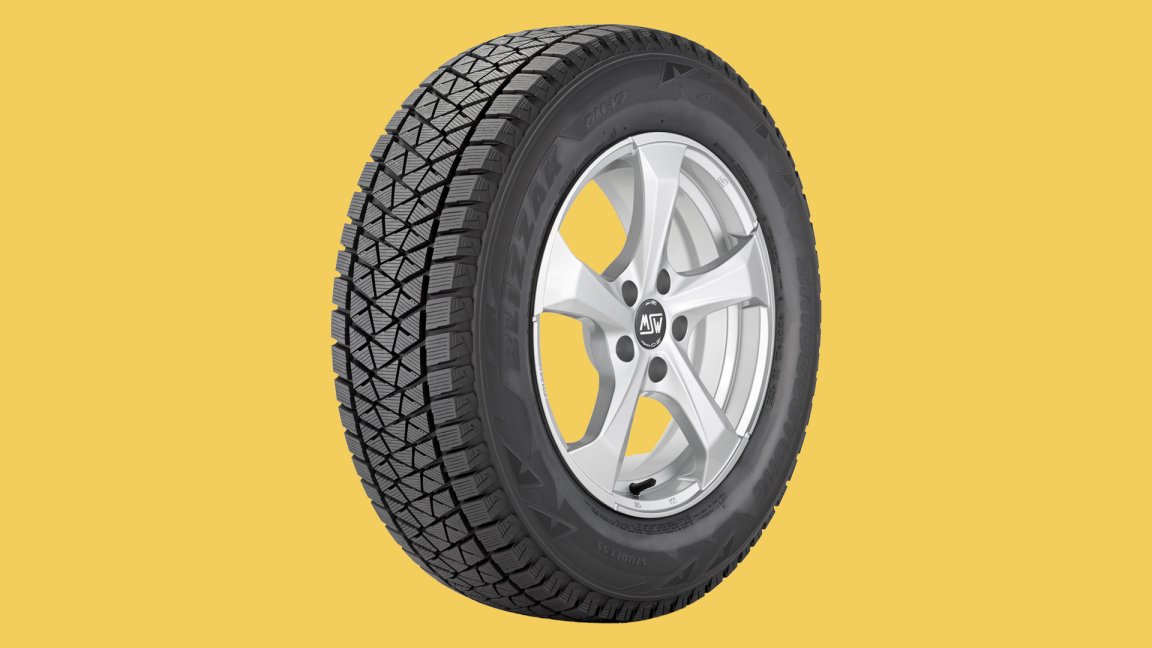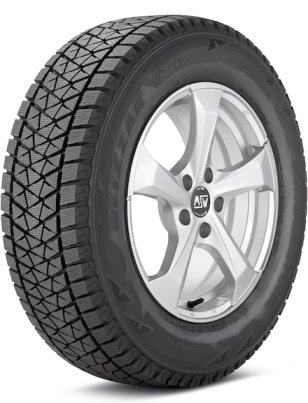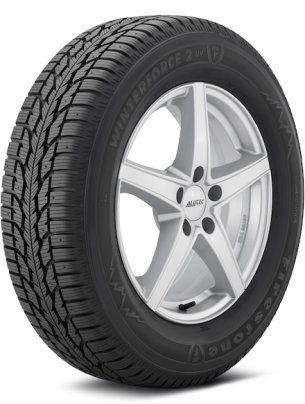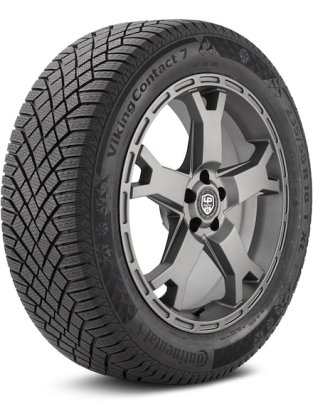We may earn revenue from the products available on this page and participate in affiliate programs. Learn more ›

Should you use winter tires on your SUV? A lot of people in your area use all-season tires without a hitch. Bully for them. You might have to travel the unkept roads they have the fortune of avoiding when the snow comes. They might also live just a mile or less from work, the grocery store, or anywhere else they need to be during the season. That isn’t to say that it doesn’t help to ask locally when you decide on which tire to use, it just means that the exact situation you’re facing is the ultimate deciding factor. Which is right for you? Well, that can be hard to say.
But The Drive is here to make some recommendations and share some insight on how to pick the right set. Let’s go!
Summary List
- Best Overall: Bridgestone BLIZZAK DM-V2
- Best Value: Firestone WINTERFORCE 2 UV
- Honorable Mention: Continental VIKINGCONTACT 7
- Best All-Season: Michelin CROSSCLIMATE2
- Best All Weather: Vredestein QUATRAC PRO
- Best All-Terrain: BFGoodrich ALL-TERRAIN T/A KO2
- Best Studdable: General Tire ALTIMAX ARCTIC 12
- Honorable Mention: Nokian Hakkapeliitta R3
Our Methodology
We can’t put our own hands on every item available. In these instances, we put our collective experience in journalism, research, and prior product testing to use to make our product picks. Items that are used by our own staff may get earnest endorsements as well, but we’ll never accept fees or bonuses to sell you stuff we’re not actually excited about. Affiliate revenue is always disclosed.
The Drive aggregates reviews and research from all over the internet to figure out which products are worth buying. We also put out shopping guides to help you understand how to assess the value of these things on your own.
Best Winter Tires for SUV: Review & Buying Guide
Best Overall: Bridgestone BLIZZAK DM-V2
Pros
- Excels on snowy roads
- Built to handle moisture and black ice
- Decent dry-road performance
Cons
- Relatively high road noise
- Poor dry-road handling
Including the Bridgestone Blizzak on this list probably isn’t much of a surprise to many. As one of the more aggressive studless winter tires, this is something of a go-to for people who routinely face snow-covered roads in some of the harsher winter regions. It utilizes an adaptive NanoPro Tech Multicell compound to combat freezing temperatures, black ice, and moisture. On top of that, the tread features a directional zig-zag pattern to promote superior grip in snow and slush.
It’s also worth noting that while the Blizzak excels in harsher conditions, dry-road performance is compromised as little as possible. As with all things, there are drawbacks. The most obvious is the price, which is considerably higher than some of the other options out there. Also, some reviewers point out that road noise is high on dry pavement, but these issues are justifiable compromises in the name of safe winter driving.
Best Value: Firestone WINTERFORCE 2 UV
Pros
- Affordable
- Pre-molded to accept studs
- Excellent winter performance
Cons
- Excellent winter performance reduces once worn down to 50 percent
- Limited sizing
Don’t let the title of Best Value fool you into thinking that the Firestone Winterforce is a cheap winter tire. Despite the lower price, this tire seems to handle northern winters on either seaboard. Thanks to the well-thought-out directional tread pattern, high sipe count, and winter compound, it’s able to contend with many of the pricier options on snowy roads. And if things take a turn for the worst, they are pre-molded to accept studs.
While there are plenty of great features, the sipes don’t run nearly as deep as they do on other tires, leading drivers to believe performance suddenly drops around the halfway point in tread life. The ability to handle tougher conditions can also compromise dry-road performance.
Honorable Mention: Continental VIKINGCONTACT 7
Pros
- Excellent comfort on dry roads
- Excels in snow and slush
- Longer than average tread life
Cons
- High price point
- Relatively poor performance on ice
The VikingContact from Continental is another heavy hitter for the country’s north. These handle snow and slush like champs but also perform well on dry pavement. Some drivers feel these are an upgrade since performance and comfort are improved across the board and tread life is longer than average. The VikingContact uses a specialized Nordic compound to get the job done. Its exotic tread pattern helps these tires to excel in most winter driving scenarios.
Unfortunately, the cost of the Continentals is going to shock many SUV owners. According to many reviewers, despite the higher price, these are also easily outmatched by more affordable options on ice.
Best All-Season: Michelin CROSSCLIMATE2
Pros
- Respectable year-round performance
- Low road noise
- Long tread life
Cons
- Not ideal for harsh winter conditions
- Premium price point
The CrossClimate2 is almost a cheat code for car and SUV owners. It might be the best all-around tire for these platforms on the market. It’s designed to offer supreme year-round performance and excellent tread-wear characteristics regardless of the conditions. It is a true all-season tire that bears the infamous Three Peak Mountain Snowflake (3PMSF) certification common to winter tires. Thanks to Michelin’s specialized combination of a carefully engineered tread pattern, compound, and noise-canceling technology, there aren’t many drawbacks for those who experience all four seasons.
While it is better than most all-seasons in the winter, it still won’t contend with a true winter tire in the northernmost parts of the country. Also, the well-rounded performance characteristics make this the most expensive tire on our list, ranking it among the likes of high-performance and off-road tires.
Best All Weather: Vredestein QUATRAC PRO
Pros
- Decent year-round performance
- Economical pricing
- Long tread life
Cons
- Not ideal for adverse winter conditions
- High road noise at low speeds
The Quatrac Pro is another solid option for those who’d rather run a single set of tires all year. It’s a grand-touring all-weather tire that offers decent summer performance and comfort driving but is still equipped to handle heavy layers of snow. Despite positive reviews claiming it to rank among some of the more familiar names in the tire world, the Quatrac Pro sits at an affordable price point.
That said, they also seem to have decent tread life. You can’t expect these to contend with a true winter tire in the worst conditions. Also, these are reported to produce plenty of road noise at low speeds, which is a fair compromise for everything they bring to the table.
Best All-Terrain: BFGoodrich ALL-TERRAIN T/A KO2
Pros
- Solid performance on all surfaces
- Can be run all year long
- Good performance in winter conditions
Cons
- Noisy
- Not the best ride quality
The T/A KO2 gets the honor of best all-terrain tire on this list. Despite what the race-derived tread and rigid construction may lead you to believe, these are relatively mild-mannered tires as far as all-terrains go — at least when it comes to the street. As for off-road performance, this truly is a go-anywhere tire that’s perfect for blasting around trails without having to tow the rig there. They also carry the 3PMSF insignia that boasts exceptional performance in winter conditions.
It’s still an all-terrain tire at the end of the day, so there are some drawbacks. On-road driving is accompanied by road noise, and these aren’t as comfortable as a regular street tire. Also, this is one of the most expensive options on the list.
Best Studdable: General Tire ALTIMAX ARCTIC 12
Pros
- Comfortable in wintry mix
- Studdable
- Doesn’t need studs to perform well in snow
Cons
- Poor wet/dry pavement performance
- Road noise can be an issue
The AltimaxArctic12 is not the first studdable winter tire on this list, but it’s one that’s hard to ignore for particularly harsh areas. It offers decent performance in the snow, even before you give it teeth. General’s recipe for this tire includes a specially designed winter compound paired with a directional tread pattern. This combination makes for a winter tire that can bite into layers of snow for traction while remaining controllable and comfortable in wintry conditions.
These tires are notoriously poor performers outside of that territory, though. Wet or dry pavement can be serious issues, meaning you can expect to change driving styles frequently in some areas. Also, it seems as though road noise is something of an issue at highway speeds.
Honorable Mention: Nokian Hakkapeliitta R3
Pros
- Excellent performance in snow and ice
- Decently comfortable in characteristics in harsh conditions
- Low rolling resistance
Cons
- OK performance on clear pavement
- High price
The Hakkapeliitta comes with a gnarly set of chompers. These tires nearly perform like studded meats, and are the perfect match for the SUV owners dealing with heavy winter conditions. The winter compound and directional tread make sure you can maneuver safely down those treacherous roads. It’s also made with an eco-friendly compound that works to reduce rolling resistance, meaning you can worry less about excessive fuel consumption as you go.
As a focused winter tire, you can’t expect it to handle pavement as well as the alternative. These also have a price tag that’s significantly higher than many studless tire options.
Our Verdict on the Best Winter Tires for SUVs
After combing through a lot of truly excellent options, we handed the crown to the OG, the Bridgestone BLIZZAK DM-V2. It’s got the best all-around performance for the price, and is a crowd favorite for a reason. To save a little coin, the Firestone WINTERFORCE 2 UV ain’t bad, either.
Features You Should Know
Types of winter tires
Studless: A studless winter tire can look a whole lot like an all-season or all-whether tire to the untrained eye. There are some major differences, though. You’ll notice that most winter tires have deeper tread blocks and more sipes. Many feature a directional pattern, which all comes together for a slightly more aggressive-looking tire.
While the tread features are important to winter performance, they’re not all there is to consider. The compounds and chemical formulas used are also essential to winter performance. Winter tires are much softer than other tire types to help them remain pliable and maintain traction when temperatures drop below roughly 40 degrees Fahrenheit. So, even if you live in an area with relatively well-kept roads, studless winter tires are a wise choice.
Studded/Studdable: A stud is a simple cylindrical metal component that’s installed to the tire’s tread to add a little more bite in wintry conditions. Where even the best winter tires may fail to get a grip in ice and snow, the studs dig a little deeper to provide the necessary traction.
Most of us won’t need studs. These are generally intended for more extreme ice and snow conditions. Studdable tires are a great option for those who live in something of a grey area since studs can be added if conditions are generally mild but can become treacherous.
All-Season/All-Weather: The nice thing about all-season tires—and the heavier-duty all-weather tires—is that you won’t need to worry about swapping tires as seasons change. This is very handy for areas where winters remain relatively mild and the streets traveled are well kept. Unfortunately, they still won’t perform as well in wintry mixes as a respectable winter tire will, even with the 3PMSF rating stamped on the side.
FAQs
You’ve got questions. The Drive has answers.
Yes, SUVs still need winter tires. Even if they have weight in their favor and different driving modes for the conditions, the tires are still on the front line. Having a set that is designed specifically to function in the snow will make a difference.
If you’re in an area where snow and ice cover the roads you drive, then yes. Winter tires are always worth it in these conditions. Even if the roads are relatively clean, a winter tire’s ability to remain pliable and supply traction in the cold months can ultimately be the best match.
Only if you live in an area where conditions are wintry all year long. Winter tires are soft, and they’ll wear rapidly when spring and summer conditions roll around. There’s also the matter of poor tire performance, which will result in poor fuel economy, acceleration, and so on.
That depends, but not in snow. It all comes down to the situations you’re dealing with. If the roads you drive on are well-kept and winter conditions are relatively mild, an all-season tire can be just as good or better than a winter tire. However, a winter tire will always be better on poorly kept roads in harsh conditions.
It’s best to remove winter tires when temperatures are steadily above 45 degrees Fahrenheit. That doesn’t mean you should panic over that warm January day. Just change the tires when spring has returned to your area.



